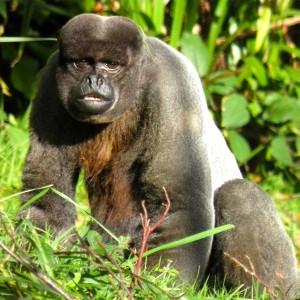


Murrayton House, St. Martin,
Near Looe, PL13 1NZ
Tel: (01503) 262532
Email: info@wildfutures.org
Web: www.monkeysanctuary.org
Web: www.visitcornwall.com/things-to-do/nature-and-wildlife/wild-futures-monkey-sanctuary
Meet a natural colony of woolly monkeys
The Monkey Sanctuary is situated in a beautiful wooded setting overlooking Looe Bay. For over thirty years The Victorian house and gardens have been the home of a natural colony of woolly monkeys.
Extensive grassed enclosures, heated indoor rooms and access to the trees provide an environment in which the monkeys can thrive; they regard this as their territory. Four generations of these beautiful monkeys, all born in Cornwall, may now be seen at the Sanctuary.
Inside their territory the monkeys move with confidence and grace - swinging on the ropes and often hanging by their tails. Young monkeys play together while others relax and groom one another. The adult males demonstrate their strength, speed and agility or quietly watch over the group ensuring all is well.
In the Sanctuary gardens visitors may also meet some of the monkeys on their regular visits to the areas outside their own territory. Monkeys forage for insects in the undergrowth and climb the trees to find leaves and nuts.
The Woolly Monkey is one of the largest and most beautiful of the South American primates. It lives in the middle and Upper Amazon basin to the west of the rivers Negro and Tapajos. There are four sub-species of woolly monkey recognised.
Woolly monkeys are arboreal, spending most of their time high in the canopy of the trees and rarely venturing to the forest floor. They have evolved in a way which enables them to exploit this treetop niche, to travel easily along narrow limbs, to reach nuts, seed-pods and fruit at the ends of branches, to leap between gaps safely and even to sleep securely 150 feet above the ground.
The most striking adaptation of a woolly monkey is the prehensile tail, which acts as a powerful fifth limb. It is easily capable of supporting the full weight of a monkey as it hangs from a branch, free the hands and feet for other uses such as collecting food.
Woolly monkeys, like humans, have forward-facing eyes. This allows stereoscopic vision for judging depth and distance, important for leaps taken in the treetops. Primatologists have discovered that they especially sensitive to the colour green, enabling them to decipher many different shades in the green world of the trees.
The Sanctuary staff are always available to answer questions and to explain points of interest - thus helping visitors to experience a unique insight into the fascinating world of a woolly monkey group. Talks are given throughout the day explaining monkey life at the Sanctuary as well how to behave if you meet a woolly monkey in the gardens.
Wildlife finds the peaceful setting of the Sanctuary a haven. Many species of animals, birds and plants may be seen in the meadow, wildlife gardens and ponds and a fascinating variety of edible and medicinal plants can be found in the forest garden.
The Monkey Sanctuary was established in 1964 by the late Leonard Williams, father of John Williams (guitarist), and a team of co-workers. The initial aim of the Sanctuary was to provide a stable setting in which woolly monkeys, rescued from lives of isolation in zoos or as pets, could live as naturally as possible. The Sanctuary received worldwide recognition as the first place where this beautiful species has survived and bred outside its own habitat and their descendants form the colony living at the Sanctuary today.
The Amazon Rainforest - the natural habitat of the woolly monkey - is threatened with destruction. Indoor exhibitions examine these threats to the world's most diverse natural area and also look at local conservation issues. Further displays cover monkey life at the Sanctuary and in the wild, the ethics and problems of captivity, ideas for rehabilitation and other animal welfare issues.
The Monkey Sanctuary is today a Co-operative Company owned and run by the keepers. All profits are used for the well-being of the monkeys and for conservation work.
The sanctuary will be closed to visitors for the 2025 season due to cost cutting measures.
A large free parking area, educational displays, shop, light refreshments, wildlife area and adventure playground.
Talks about the monkeys are held throughout the day.
Allow at least two hours for your visit.
The Tea Room Settle down for a cup of tea or coffee and a slice of cake, or a warming vegan pasty in the Tea Room and Gift Shop, situated in the original dining room of Murrayton House. Browse our adoptions booklet where you can find out more about all of the monkeys you have seen around the Sanctuary.
Sign-posted form the B3253 two miles east of Looe.
Opening Times1st April to 30th October Admission Charged |
Downderry Looe Seaton Valley Country Park Seaton The Coastal Footpath